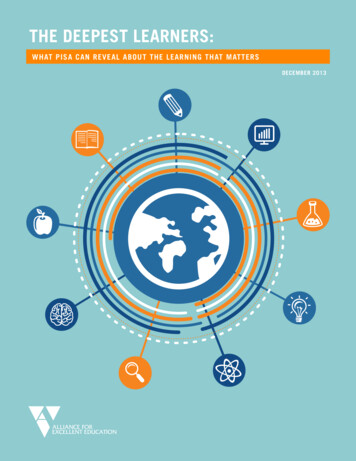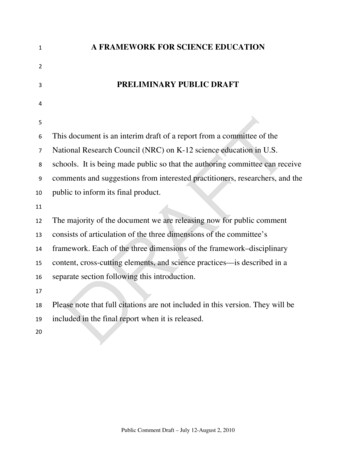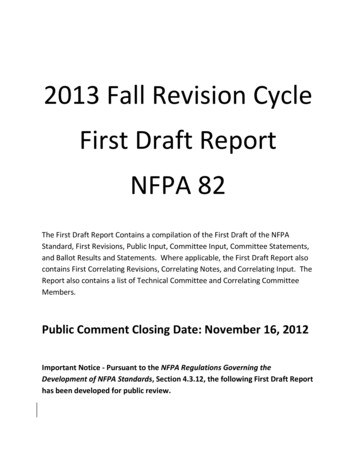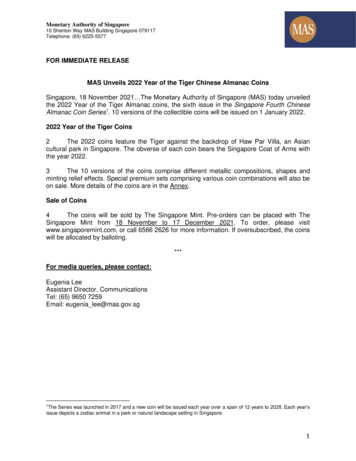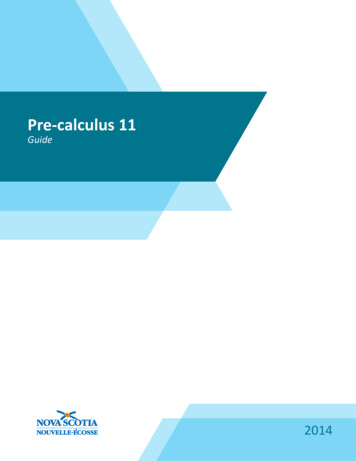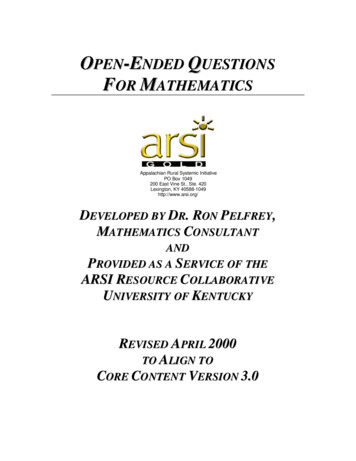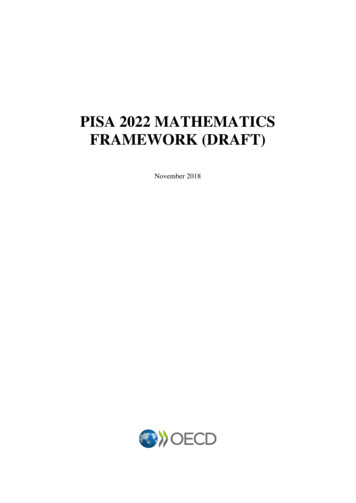
Transcription
1PISA 2022 MATHEMATICSFRAMEWORK (DRAFT)November 2018PUBE
2 Table of contentsIntroduction . 3Definition of Mathematical Literacy . 6A View of Mathematically Literate Individuals in PISA 2022. 8An Explicit Link to a Variety of Contexts for Problems in PISA 2022 . 12A Visible Role for Mathematical Tools, including Technology in PISA 2022 . 12Organisation of the Domain . 14Mathematical Reasoning and Problem Solving Processes . 14Mathematical Content Knowledge . 22Contexts for the assessment items and selected 21st century skills . 28Assessing Mathematical Literacy . 32Structure of the PISA 2022 Mathematics Assessment. 32Desired Distribution of Score Points by Mathematical Reasoning and Problem solving process . 32Desired Distribution of Score Points by Content Category . 33A Range of Item Difficulties. 33Computer-based Assessment of Mathematics . 36Design of the PISA 2022 Mathematics Items . 38Item Scoring. 39Reporting Proficiency in Mathematics . 39Mathematical Literacy and the Background Questionnaires . 40Summary . 43References . 44Annex A. Illustrative examples . 47TablesTable 1. Approximate distribution of score points by domain for PISA 2022 . 33Table 2. Approximate distribution of score points by content category for PISA 2022 . 33Table 3. Expected student actions for mathematical reasoning and each of the problem solvingprocesses. 35FiguresFigure 1. Mathematical literacy: the relationship between mathematical reasoning and the problemsolving (modelling) cycle. . 8Figure 2. PISA 2022: the relationship between mathematical reasoning, the problem solving(modelling) cycle, mathematical contents, context and selected 21st century skills. 10Figure 3. Example of the PISA 2018 editor tool . 39
3Introduction1.The assessment of mathematics has particular significance for PISA 2022, asmathematics is again the major domain assessed. Although mathematics was assessed byPISA in 2000, 2003, 2006, 2009, 2012, 2015 and 2018, the domain was the main areaof focus only in 2003 and 2012.2.The return of mathematics as the major domain in PISA 2022 provides boththe opportunity to continue to make comparisons in student performance over time, and tore-examine what should be assessed in light of changes that have occurred in the world, thefield and in instructional policies and practices.3.Each country has a vision of mathematical competence and organises theirschooling to achieve it as an expected outcome. Mathematical competence historicallyencompassed performing basic arithmetic skills or operations, including adding,subtracting, multiplying, and dividing whole numbers, decimals, and fractions; computingpercentages; and computing the area and volume of simple geometric shapes. In recenttimes, the digitisation of many aspects of life, the ubiquity of data for making personaldecisions involving initially education and career planning, and, later in life, healthand investments, as well as major societal challenges to address areas such as climatechange, governmental debt, population growth, spread of pandemic diseasesand the globalising economy, have reshaped what it means to be mathematically competentand to be well equipped to participate as a thoughtful, engaged, and reflective citizen in the21st century.4.The critical issues listed above as well as others that are facing societies throughoutthe world all have a quantitative component to them. Understanding them, as well asaddressing them, at least in part, requires being mathematically literate and thinkingmathematically. Such mathematical thinking in more and more complex contexts is notdriven by the reproduction of the basic computational procedures mentioned earlier, butrather by reasoning1 (both deductive and inductive). The important role of reasoning needsgreater emphasis in our understanding of what it means for students to be mathematicallyliterate. In addition to problem solving, this framework argues that mathematical literacyin the 21st century includes mathematical reasoning and some aspects of computationalthinking.5.Countries today face new opportunities and challenges in all areas of life, manyof which stem from the rapid deployment of computers and devices like robots,smartphones and networked machines. For example, the vast majority of young adults andstudents who started university post 2015 have always considered phones to be mobilehand-held devices capable of sharing voice, texts, and images and accessing the internet –capabilities seen as science fiction by many of their parents and certainly by all of theirgrandparents (Beloit College, 2017[1]). The recognition of the growing contextualdiscontinuity between the last century and the future has prompted a discussion around thedevelopment of 21st century skills in students (Ananiadou and Claro, 2009[2]; Fadel, Bialikand Trilling, 2015[3]; National Research Council, 2012[4]; Reimers and Chung, 2016[5]).1Throughout this framework, references to mathematical reasoning assume both mathematical(deductive) and statistical (inductive) type reasoning.
4 6.It is this discontinuity that also drives the need for education reformand the challenge of achieving it. Periodically, educators, policy makers, and otherstakeholders revisit public education standards and policies. In the course of thesedeliberations new or revised responses to two general questions are generated: 1) What dostudents need to learn, and 2) Which students need to learn what? The most used argumentin defence of mathematics education for all students is its usefulness in various practicalsituations. However, this argument alone gets weaker with time – a lot of simple activitieshave been automated. Not so long ago waiters in restaurants would multiply and add onpaper to calculate the price to be paid. Today they just press buttons on hand-held devices.Not so long ago people used printed timetables to plan travel – it required a goodunderstanding of the time axis and inequalities as well as interpreting complex two-waytables. Today we can just make a direct internet inquiry.7.As to the question of “what to teach”, many restrictive understandings arise fromthe way mathematics is conceived. Many people see mathematics as no more than a usefultoolbox. A clear trace of this approach can be found in the school curricula of manycountries. These are sometimes confined to a list of mathematics topics or procedures, withstudents asked to practice a selected few, in predictable (often test) situations. Thisperspective on mathematics is far too narrow for today’s world. It overlooks key featuresof mathematics that are growing in importance. Notwithstanding the above remark, thereare an increasing number of countries that emphasise reasoning and the importance ofrelevant contexts in their curricula. Perhaps these countries cab serve as helpful models toothers.8.Ultimately the answer to these questions is that every student should learn (and begiven the opportunity to learn) to think mathematically, using mathematical reasoning (bothdeductive and inductive) in conjunction with a small set of fundamental mathematicalconcepts that support this reasoning and which themselves are not necessarily taughtexplicitly but are made manifest and reinforced throughout a student’s learningexperiences. This equips students with a conceptual framework through which to addressthe quantitative dimensions of life in the 21st century.9.The PISA 2022 framework is designed to make the relevance of mathematics to15-year-old students clearer and more explicit, while ensuring that the items developedremain set in meaningful and authentic contexts. The mathematical modelling cycle, usedin earlier frameworks (e.g. OECD (2004[6]; 2013[7])) to describe the stages individuals gothrough in solving contextualised problems, remains a key feature of the PISA 2022framework. It is used to help define the mathematical processes in which students engageas they solve problems – processes that together with mathematical reasoning (bothdeductive and inductive) will provide the primary reporting dimensions.10.For PISA 2022, computer-based assessment of mathematics (CBAM) will bethe primary mode of delivery for assessing mathematical literacy. However, paper-basedassessment instruments will be provided for countries choosing not to test their students bycomputer. The framework has been updated to also reflect the change in delivery modeintroduced in 2015, including a discussion of the considerations that should inform thedevelopment of the CBAM items as this will be the first major update to the mathematicsframework since computer-based assessment was introduced in PISA.11.The development of the PISA 2022 framework takes into account the expectationof OECD that there will be an increase in the participation in PISA of lowand middle-income countries. In particular the PISA 2022 framework recognises the needto increase the resolution of the PISA assessments at the lower end of the student
5performance distribution by drawing from the PISA for Development (OECD, 2017[8])framework when developing the assessment; the need to expand the performance scale atthe lower end; the importance of capturing a wider range of social and economic contexts;and the anticipation of incorporating an assessment of out-of-school 14- to 16-year-olds.12.The increasing and evolving role of computers and computing tools in bothday-to-day life and in mathematical literacy problem solving contexts is reflected inthe recognition in the PISA 2022 framework that students should possess and be able todemonstrate computational thinking skills as they apply to mathematics as part of theirproblem-solving practice. Computational thinking skills include pattern recognition,designing and using abstraction, pattern decomposition, determining which (if any)computing tools could be employed in analysing or solving a problem, and definingalgorithms as part of a detailed solution. By foregrounding the importance of computationalthinking as it applies to mathematics, the framework anticipates a reflection byparticipating countries on the role of computational thinking in mathematics curricula andpedagogy.13.The PISA 2022 mathematics framework is organised into three major sections.The first section, ‘Definition of Mathematical Literacy’, explains the theoreticalunderpinnings of the PISA mathematics assessment, including the formal definition of themathematical literacy construct. The second section, ‘Organisation of the Domain’,describes four aspects: a) mathematical reasoning and the three mathematical processes (of themodelling/problem solving cycle); b) the way mathematical content knowledge isorganised in the PISA 2022 framework, and the content knowledge that is relevant toan assessment of 15-year-old students; c) the relationship between mathematical literacyand the so-called 21st Century skills; and d) the contexts in which students will facemathematical challenges. The third section, ‘Assessing Mathematical Literacy’, outlinesstructural issues about the assessment, including a test blueprint and other technicalinformation.14.For the sake of ensuring the preservation of trend, the majority of the items inthe PISA 2022 will be items that have been used in previous PISA assessments. A largecollection of release items based on the previous framework can be found athttp://www.oecd.org/pisa/test. Annex A provides seven illustrative items that attempt toillustrate the most important new elements of the 2022 framework.15.The 2022 framework was written under the guidance of the 2022 mathematicsexpert group (MEG), a body appointed by the PISA contractor for the mathematicsframework (RTI International), in consultation with the PISA Governing Board (PGB).The eight MEG members included mathematicians, statisticians, mathematics educators,and experts in assessment, technology, and education research from a range of countries.The MEG were further supported by an extended MEG (eMEG) group, made up of tenexperts acting as peer reviewers of the framework version created by the MEG. The eMEGincluded experts with a range of mathematics expertise from differing countries. Additionalreviews were undertaken by experts on behalf of the over 80 countries constituting thePISA Governing Board. RTI International, as contracted by the Organisation for EconomicCo-operation and Development (OECD), conducted two further research efforts: a facevalidity validation survey amongst educators, universities and employers; and a cognitivelaboratory with 15-year-olds in different countries to obtain student feedback on the sampleitems presented in the framework. The work of the PISA 2022 MEG builds on previousversions of the PISA Mathematics Framework and incorporates the recommendations ofthe Mathematics Strategic Advisory Group convened by OECD in 2017.
6 Definition of Mathematical Literacy16.An understanding of mathematics is central to a young person’s preparedness forparticipation in and contribution to modern society. A growing proportion of problems andsituations encountered in daily life, including in professional contexts, require some levelof understanding of mathematics before they can be properly understood and addressed.Mathematics is a critical tool for young people as they confront a wide range of issues andchallenges in the various aspects of their lives.17.It is therefore important to have an understanding of the degree to which youngpeople emerging from school are adequately prepared to use mathematics to think abouttheir lives, plan their futures, and reason about and solve meaningful problems related to arange of important issues in their lives. An assessment at age 15 provides countries with anearly indication of how individuals may respond in later life to the diverse arrayof situations they will encounter that both involve mathematics and rely on mathematicalreasoning (both deductive and inductive) and problem solving to make sense of.18.As the basis for an international assessment of 15-year-old students, it is reasonableto ask: “What is important for citizens to know and be able to do in situations that involvemathematics?” More specifically, what does being mathematically competent mean for a15-year-old, who may be emerging from school or preparing to pursue more specialisedtraining for a career or university admission? It is important that the construct ofmathematical literacy, which is used in this framework to denote the capacity of individualsto reason mathematically and solve problems in a variety of 21st century contexts, not beperceived as synonymous with minimal, or low-level, knowledge and skills. Rather, it isintended to describe the capacities of individuals to reason mathematically and usemathematical concepts, procedures, facts and tools to describe, explain and predictphenomena. This conception of mathematical literacy recognises the importance ofstudents developing a sound understanding of a range of mathematical concepts andprocesses and realising the benefits of being engaged in real-world explorations that aresupported by that mathematics. The construct of mathematical literacy, as defined forPISA, strongly emphasises the need to develop students’ capacity to use mathematics incontext, and it is important that they have rich experiences in their mathematics classroomsto accomplish this. This is as true for those 15-year-old students who are close to the endof their formal mathematics training, students who will continue with the formal study ofmathematics, as well as out of school 15-year-olds.19.Mathematical literacy transcends age boundaries. For example, OECD'sProgramme for the International Assessment of Adult Competencies (PIAAC) definesnumeracy as the ability to access, use, interpret, and communicate mathematicalinformation and ideas, in order to engage in and manage the mathematical demandsof a range of situations in adult life. The parallels between this definition for adults and thePISA 2022 definition of mathematical literacy for 15-year-olds are both marked andunsurprising.20.The assessment of mathematical literacy for 15-year-olds must take into accountrelevant characteristics of these students; hence, there is a need to identify age-appropriatecontent, language and contexts. This framework distinguishes between broad categories ofcontent that are important to mathematical literacy for individuals generally, and thespecific content topics that are appropriate for 15-year-old students. Mathematical literacy
7is not an attribute that an individual either has or does not have. Rather, mathematicalliteracy is an attribute that is on a continuum, with some individuals being moremathematically literate than others – and with the potential for growth always present.21.For the purposes of PISA 2022, mathematical literacy is defined as follows:Mathematical literacy is an individual’s capacity to reason mathematically and toformulate, employ, and interpret mathematics to solve problems in a variety of realworld contexts. It includes concepts, procedures, facts and tools to describe,explain and predict phenomena. It assists individuals to know the role thatmathematics plays in the world and to make the well-founded judgmentsand decisions needed by constructive, engaged and reflective 21st century citizens.22.The PISA 2022 framework, when compared with the PISA 2003 and PISA 2012frameworks, while appreciating and preserving the basic ideas of mathematical literacydeveloped there, acknowledges a number of shifts in the world of the student which in turnsignal a shift on how to assess mathematical literacy in comparison to the approach used inprevious frameworks. The trend is to move away from the need to perform basiccalculations to a rapidly changing world driven by new technologies and trends in whichcitizens are creative and engaged, making judgements for themselves and the society inwhich they live.23.As technology will play a growing role in the lives of students, the long-termtrajectory of mathematical literacy should also encompass the synergistic and reciprocalrelationship between mathematical thinking and computational thinking, introduced in(Wing 20062) as “the way computer scientists think” and regarded as a thought processentailed in formulating problems and designing their solutions in a form that can beexecuted by a computer, a human, or a combination of both (Wing 20103) (Cuny, Snyderand Wing, 2010[9]). The roles computational thinking play in mathematics include howspecific mathematical topics interact with specific computing topics, and howmathematical reasoning complements computational thinking (Gadanidis, 2015[10];Rambally, 2017[11]). For example, Pratt and Noss (2002[12]) discuss the useof a computational microworld for developing mathematical knowledge in the caseof randomness and probability; Gadanidis et al. (2018[13]) propose an approach to engageyoung children with ideas of group theory, using a combination of hands-onand computational thinking tools. Hence, while mathematics education evolves in terms ofthe tools available and the potential ways to support students in exploring the powerfulideas of the discipline (Pei, Weintrop and Wilensky, 2018[14]), the thoughtful useof computational thinking tools and skill sets can deepen the learning of mathematicscontents by creating effective learning conditions (Weintrop et al., 2016[15]). Moreover,computational thinking tools offer students a context in which they can reify abstractconstructs (by exploring and engaging with maths concepts in a dynamic way) (Wing20084), as well as express ideas in new ways and interact with concepts through media and2 (Wing2006) is J.Wing, Computational Thinking, Communications of the ACM, Vol. 49, No. 3,March 2006, pp. 33–35.3 J. Wing, Computational Thinking – What and Why?, The Magazine of Carnegie Mellon -why.4J. Wing, Computational thinking and thinking about computing, Philosophical Transactions of The RoyalSociety A, 366:3717-3725, 2008
8 new representational tools (Grover, 2018[16]; Niemelä et al., 2017[17]; Pei, Weintrop andWilensky, 2018[14]; Resnick et al., 2009[18]).A View of Mathematically Literate Individuals in PISA 202224.The focus of the language in the definition of mathematical literacy is on activeengagement with mathematics to solve real-world problems in a variety of contexts, and isintended to encompass mathematical reasoning (both deductive and inductive)and problem solving using mathematical concepts, procedures, facts and tools to describe,explain and predict phenomena.25.It is important to note that the definition of mathematical literacy not only focuseson the use of mathematics to solve real-world problems, but also identifies mathematicalreasoning as a core aspect of being mathematically literate. The contribution thatthe PISA 2022 framework makes is to highlight the centrality of mathematical reasoningboth to the problem solving cycle and to mathematical literacy in general.26.Figure 1 depicts the relationship between mathematical reasoning (both deductiveand inductive) and problem solving as reflected in the mathematical modelling cycleof both the PISA 2003 and PISA 2012 framework.Figure 1. Mathematical literacy: the relationship between mathematical reasoning and theproblem solving (modelling) cycle.27.In order for students to be mathematically literate they must be able, first to usetheir mathematics content knowledge to recognise the mathematical nature of a situation(problem) especially those situations encountered in the real world and then to formulate itin mathematical terms. This transformation – from an ambiguous, messy, real-worldsituation to a well-defined mathematics problem – requires mathematical reasoning. Oncethe transformation is successfully made, the resulting mathematical problem needs to besolved using the mathematics concepts, algorithms and procedures taught in schools.However, it may require the making of strategic decisions about the selection of those toolsand the order of their application – this is also a manifestation of mathematical reasoning.Finally, the PISA definition reminds us of the need for the student to evaluate themathematical solution by interpreting the results within the original real-world situation.Additionally, students should also possess and be able to demonstrate computational
9thinking skills as part of their problem-solving practice. These computational thinkingskills which are applied in formulating, employing, evaluating and reasoning includepattern recognition, decomposition, determining which (if any) computing tools could beemployed in the analysing or solving the problem, and defining algorithms as part of adetailed solution.28.Although mathematical reasoning and solving real-world problems overlap, thereis an aspect to mathematical reasoning which goes beyond solving practical problems.Mathematical reasoning is also a way of evaluating and making arguments, evaluatinginterpretations and inferences related to statements (e.g. in public policy debates etc.) andproblem solutions that are, by their quantitative nature, best understood mathematically.29.Mathematical literacy therefore comprises two related aspects: mathematicalreasoning and problem solving. Mathematical literacy plays an important role in being ableto use mathematics to solve real-world problems. In addition, mathematical reasoning (bothdeductive and inductive) also goes beyond solving real-world problems to include themaking of informed judgements about that important family of societal issues which canbe addressed mathematically. It also includes making judgements about the validity ofinformation that bombards individuals by means of considering their quantitative andlogical, implications. It is here where mathematical reasoning also contributes to thedevelopment of a select set of 21st century skills (discussed elsewhere in the framework).30.The outer circle of Figure 2 shows that mathematical literacy takes place inthe context of a challenge or problem that arises in the real world.
10 Figure 2. PISA 2022: the relationship between mathematical reasoning, the problem solving(modelling) cycle, mathematical contents, context and selected 21 st century skills.31.Figure 2 also depicts the relationship between mathematical literacy as depicted inFigure 1 and: the mathematical contents domains in which mathematical literacy is applied;the problem contexts and the selected 21st century skills that are both supportive of anddeveloped through mathematical literacy.32.These categories of mathematics content include: quantity, uncertainty and data,change and relationships, and space and shape. It is these categories of mathematics contentknowledge which students must draw on to reason, to formulate the problem(by transforming the real world situation into a mathematical problem situation), tosolve the mathematical problem once formulated, and to interpret and evaluatethe solution determined.33.As in the previous frameworks, the four context areas that PISA continues to useto define real-world situations are personal, occupational, societal and scientific.The context may be of a personal nature, involving problems or challenges that mightconfront an individual or one’s family or peer group. The problem might instead be set ina societal context (focusing on one’s community – whether it be local, national or global),an occupational context (centred on the world of work), or a scientific context (relating tothe application of mathematics to the natural and technological world).
1134.Included for the first time in the PISA 2022 framework (and depicted in Figure 2)are selected 21st century skills that mathematical literacy both relies on and develops.21st century skills are discussed in greater detail in the next section of this framework. Fornow, it should be stressed that while contexts (personal, societal, occupationaland scientific) influence the development of test items, there is no expectation that itemswill be deliberately developed to incorporate or address 21st century skills. Instead,the expectation is that by responding to the spirit of the framework and in line withthe definition of mathematical literacy, the 21st century skills that have been identified willbe incorporated in the items.35.The language of the definition and the representation in Figure 1 and Figure 2 retainand integrate the notion of mathematical modelling, which has historically beena cornerstone of the PISA framework for mathematics e.g. (OECD, 2004[6]; OECD,2013[7]). The modelling cycle (formulate, employ, interpret and evaluate) is a central aspectof the PISA conception of mathematically literate students; however, it is often notnecessary to engage in every stage of the modelling cycle, especially in the contextof an assessment (Galbraith, Henn and Niss, 2007[19]). It is often the case that significantparts of the mathematical modelling cycle have been undertaken by others, and the end usercarries out some of the steps of the modelling cycle, but not all of them. For example, insome cases, mathematical representations, such as graphs or equations, are given that canbe directly manipulated in order to answer some question or to draw some conclusion. Inother cases, students may be using a computer simulation to explore the impact of variablechange in a system or environment. For this reason, many PISA items involve only partsof the modelling cycle. In reality, the problem solver may also someti
Such mathematical thinking in more and more complex contexts is not . the quantitative dimensions of life in the 21st century. 9. The PISA 2022 framework is designed to make the relevance of mathematics to . describes four aspects: a) mathematical reasoning and the three mathematical
